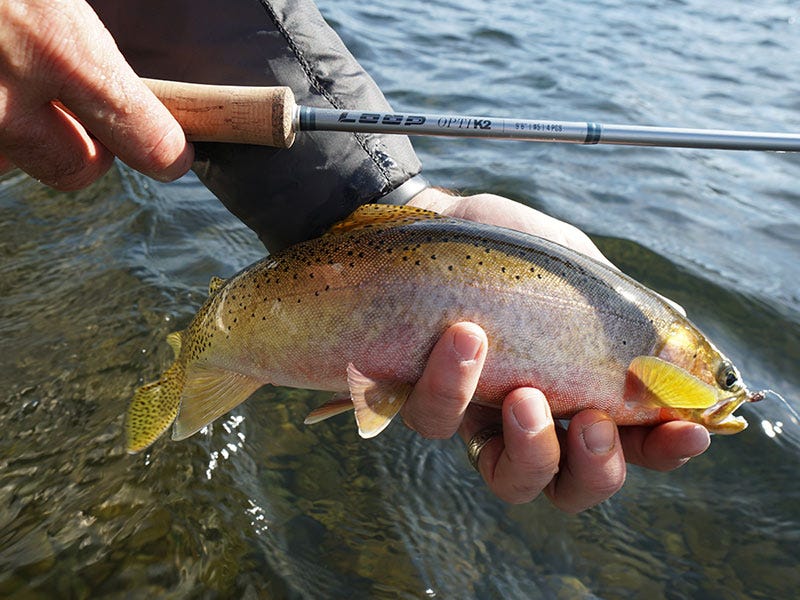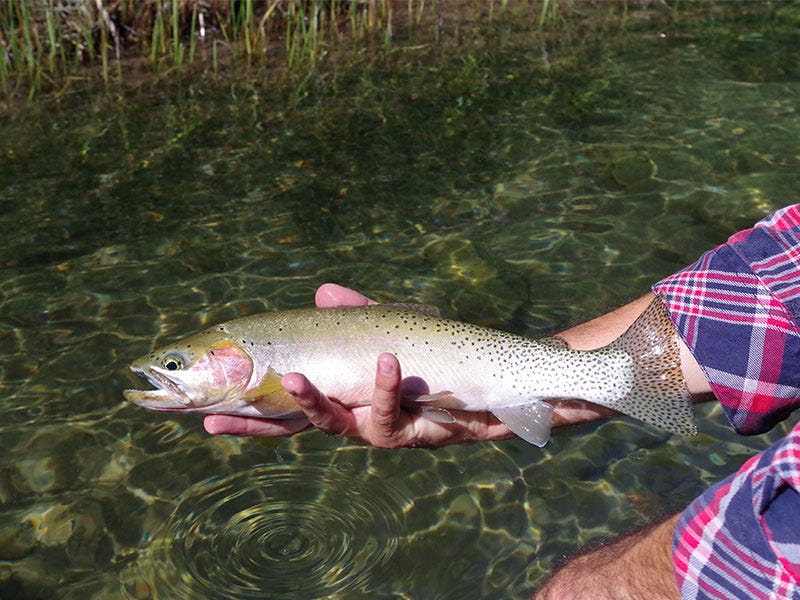Best Spring Fishing Tactics on the Coeur d'Alene

For many years, most rivers and streams in North Idaho were closed to fishing from the end of March through the Saturday before Memorial Day. The reasoning behind this closure was to let the native Westslope cutthroat do their spawning activities. The short Spring closure ended 10+ years ago and now with the wide-sweeping catch and release rules on our streams, we are allowed to fish year-round. This can be some of the best fishing of the year.
I have been in North Idaho for almost 25 years and have come to realize there is no "normal" or consistency to our weather. In North Idaho, one year we will be in t-shirts and mid-50s in March, and the next moment we’ll have blizzards and freezing temperatures. We may get excited about having a mild winter and spring and not having to shovel all that snow and long winters. However, this does not bode well for the following summer. The fish and streams rely on good snowpack and a slow melt throughout the spring and into summer. Plus, having a lower chance of forest fires and higher lake levels means better health for our resources.
Better health for our resources means we are very lucky to be able to fish most of the year, whether it is on our trout streams, lakes, or maybe a steelhead river just south of us. Let me shed some light on how I like to approach my home water, the Coeur d'Alene River, in the early spring during pre-runoff.

Where to Find River Flows and Weather?
Checking river flows in Spring is important and will help you plan your day. With the resource of the USGS site (United States Geological Survey), we can quickly look at the river flows. This, plus, knowing the road and weather conditions, you’ll be able to quickly decide whether it is worth it or not to go fishing. If you are not aware of this site, you can simply type in USGS river flows on the Coeur d'Alene river and you can see all of the different points of measurement on the river. I usually use the Cataldo site, which is the lowest point on the river that is fishable for trout.
I like to see that Coeur d'Alene is typically a stable flow or dropping for a few days below 6,000 cfs. At 6,000 cfs, the river is pretty high, but, if it’s dropping clarity usually runs between two to three feet, and the fishing can be fantastic. I prefer flows at around 2,000 cfs, mainly because I fish this river out of a drift boat most of the time. Flows below 1,500 cfs are better for a walk and wade angler and allow you to have plenty of room to fish. Keep in mind that normal summer flows (if we have good snow) are 500-600 cfs in mid-August.
Also, keep an eye on our reports at the shops and we will have weekly reports for you to see flows and what we think are good conditions to fish. You’ll also want to learn how to read the flows and decide what your comfort level is on your local streams. Another great site is the Northwest river forecast. This gives you a long-term forecast of what the rivers will do in the upcoming days and week. It combines weather, snowpack, and flows to give you a good outlook on what to expect.
Here's what's happening on the CdA right now.
Fishing the Coeur d'Alene River Tactics, Tips, and Rigs
Nymphing and streamer fishing really dominate the spring fishing on the Coeur d'Alene River. However, there can be some very good dry fly days too during the spring. Good skwalla hatches or a mix of March browns and blue winged olives are great to have, but it can be spotty. Coupled with rollercoaster flows and weather, the hatches sometimes have a hard time jump starting in the spring. It pays to become good with nymphs and streamers.
I really favor streamer fishing in the spring. It seems to be consistent throughout the changing conditions. If I were to pick one tactic, streamer fishing is what I would choose for the most success. Typically, I'll have a dry fly rod on standby with a medium size chubby in the olive variety (think stonefly) with a long dropper, usually a big pheasant tail. I like running a longer dropper off a buoyant dry stonefly as the indicator. Out of the drift boat, this is a great rig to use versus a longer, 8-9-foot-long nymph rig. You’ll be getting the best of both worlds, juicy stonefly on top and a stonefly nymph quickly sinking to the bottom. Remember though, this isn't a do-all rig. In the spring with high heavy flows, you may need a more extreme rig, 9 foot or longer indicator rig with a two to three split shot and a couple of big nymphs. If you are walk/wading, you may need to consider a switch rod in the 11-foot range. High sticking a big nymph rig or streamers, or possibly a big dry dropper, these rods shine in big water conditions.
My standard kit will be a fast action 9 foot 5 and 6-weight, usually in the Sage variety. I still fish some of the old XP models from years ago. I’ve found that the new Foundations from Sage are a blast and are nearly the same stick as the old XP -just more in the mid-price range. I like that they have the progressive action you need for more demanding conditions in the spring. I'll also have the 5-weight rigged with a dry and the 6 with either a streamer or nymph rig. I will then have them lined with Scientific Anglers Amplitude lines either in the infinity smooth or the gpx taper.
Looking for a rod of the Sage variety plus others? Order online here.
Best Flies for the Coeur d'Alene River
There are a few main players you should always have in your boxes for the spring on the Coeur d'Alene.
Midges: The midges are usually the first to show up. Not big clouds like on the Missouri or the Bighorn in comparison but enough to get the fishes attention. You will start seeing them from the end of February through June. They are bigger typically in sizes from 22-16 on the bigger size. Flies you’ll want to use; Griffith's gnats are great, palomino midges, brassies, snow cones, black para Adams. Using these in back eddies are great for these guys or in flat water in tail outs or pools.
Blue Winged Olives: The blue winged olives will make an appearance as early as late February under the right conditions. Though, it needs to be a touch warmer, as in the 40s, for a few days before we see many. They will be thicker on warmer days in the 50s and overcast or rainy days. They will maintain through the spring and summer and become stronger in the fall with cooler temps. Flies you’ll want to use; comparaduns, sparkle duns, thorax duns, snowshoe rabbits’ foot comparaduns, and olive Adams. The sizes will be from 20-16.
Need a spring hatch guide to BWOs? Read this.
Nemoura Stonefly: The nemoura stone fly or the "snow stone" as some folks call them will be crawling around the snow banks in the early spring. They are actually hatching under the snow on the rocks and making their way through the snow or edges of exposed rocks onto the bank. They will be around in late February to early March. They are slender small black stoneflies. They are around a size 14 or 16 usually and the hatch will last through May typically.
Skwalla Stonefly: The mighty Skwalla is our first "big" bug to show up -some years in great numbers and some not so great. Mid-March is about the time they show up on the CdA. It is a great hatch and exciting to fish. The hungry spring cutthroat are suckers for these guys. You’ll want to use; big bushy chubby chernobly's, rogue foam stones, olive stimulators, and the list goes on. We have a great selection for this hatch in the bins. The fly is about a size 10-8 long shank or 3X long hook. Make sure to twitch your skwalla once in a while, the trout love the twitch!
March Browns: March browns are typically a more consistent and longer hatch than the skwalla on the CdA. They are a good size mayfly. In a size 14-10. We stock a large variety of these guys from adult patterns to emergers. I love running a cdc March brown thorax with a bigger size 10 soft hackle as a dropper during this hatch. We will see these players show up in the middle of March throughout May.
Grey Drakes: The grey drakes are similar in size to the March browns and come off a little later. April is the month for these guys and they don't last too long, usually the middle of May if conditions allow. We carry some great foam extended body grey drakes with a poly wing that fit the bill nicely for this bug. Same here guys, you’ll want to run a size 10 or smaller soft hackle behind for the emerger or maybe a quigley cripple grey drake as your dropper.
Need a few main players for the box? Check out our fly selection perfect for spring.

So, these are your main players for early spring on the Coeur d'Alene River. Now, I won't really include some of the other big-name hatches. Pre-runoff is what I'm really concentrating on here. But, you can expect to see some caddis showing up in late April, maybe a golden stone, yellow sallie too. Plus, you’ll see that pale morning duns and green drakes will be the dudes in late June and early July along with many other stoneflies too.
Again, not to beat the nymph and streamer drum too much, but I'd lean to this side more so as in higher flows like we will get this year. These will be your go-to techniques. Take advantage of the CdA in the spring folks, it is less pressured, can be some great weather, and big fish to be had here. Put a big olive sculpin on and rip them off the banks and hold on! I've had some very memorable days on the CdA that would rival some of the big-name rivers in Montana.
